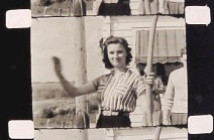The 6th annual Los Angeles HMD was accomplished only through the organizing efforts of Leah Kerr, Director of Archives at the Mayme Clayton Library & Museum (MCLM), and Academy staff Fritz Herzog and Lynne Kirste.
While eager & willing volunteers were assembled at the ready, public participation of about 25 people was low as a result of reducing PR based on last year’s record crowd at the Academy’s Linwood Dunn Theater. Discussion thus arose among several volunteers about how to transfer hosting and publicity preparation for HMD 2009 to an eager group of volunteers—-perhaps drawn from members of UCLA’s AMIA student chapter. Given the camaraderie, conversation, and connection made among volunteers, it seems a likely fit for students to sharpen old skills, develop new ones, and network with veterans in the moving-
image-archive profession.The change of LA host-site venue to the MCLM in Culver City (http://www.claytonmuseum.org/) was refreshingly informal. Avery Clayton, son of MCLM founder Mayme Clayton, was on hand to describe his mother’s one-woman initiative to establish the largest privately-held collection of African-American historical materials in the world by collecting more than 30,000 rare and out-of-print books and 1700 moving-image titles in the course of her career as a USC and later UCLA librarian.
Despite low turn-out, HMD2008 again provided the opportunity to assure a small gathering of folks how their films represent irreplaceable 20th-Century historical documents. Significantly, several of the day’s final films yielded a welcome response from those gathered within the MCLM. These included several 8mm films (possibly shot by a “Mrs. Penn of Los Angeles”) which Spencer Lee purchased at a swap meet and which captured moments of 1950s African-American life, styles, and social customs.
The value of these images rang out as Clayton Avery and a member of the Culver-City Genealogy Society attempted to identify the locations of a YWCA in front of which handsomely-appointed African-American women walked according to the cues and prompts of some unknown, off-screen amateur cinematographer. Perhaps Adams & Western? And the next reel labeled “Conference outside of church”—was it the First Baptist Church, or African Methodist Episcopal (AME)?
A third reel from Spencer projected screen-filling close-ups of a male Asian guest paying a visit to the Penn family—an intimate gathering which was perhaps a consequence of relationships that developed between African-Americans and Asians interred in “War Relocation Camps” during WWII. In light of the positive feedback, Spencer agreed to submit to the MCLM copies of the 10 reels he purchased at swap . Additionally, he agreed to provide as much identifying information about “Mrs. Penn” as he could gleam from the box in which the reels were purchased. Thus begins a search (by some future unknown researcher) to document as much as can be known about the reels. Research and social documentation aside, throughout the day Dino Everett’s 9.5mm films provided fascinating journeys into a 1930s British hobbyist’s storytelling—even told via an early split-screen effect. Watching the charming play of British school days and leap-frogging vacationers, long-passed lives & recreations were renewed on a big screen thanks to Dino’s generous provision of 9.5mm projectors. Another international contribution of the day was gorgeous footage from Peruvian and Chilean trips Eva Honegger’s grandfather made during the 1940s.
Returning to the colonies’ 8mm/16mm, slices of quotidian American life rolled out from East-Coast relatives of Trisha Lendo (Pennsylvania), Candace Lewis (New Jersey/Florida), and Lance Watsky (New York). From the west coast, Dolores Dace took us to southwest Wyoming in the 1960s and 1970s, while several of Midori Endo’s 22 reels transported us to 1950s Japanese-American Los Angeles. Staying local again, Leah Kerr’s 8mm brought us to Pomona drag racing at the turn of the 21st century, and both Larry Skuce and Rich Borony’s amateur small-gauge contributions served to remind us of celebrities at our backdoor and beck-and-call here in Tinseltown.
Other reminders of Tinseltown included two additional Spencer-Lee contributions—one a circa-1980 special-effects/makeup-artist demo reel which was very fitting for Halloween, and a second 1930s romp of costumed revelers—as well as Satchel-Paige footage from the Academy’s own home-movie collection which was screened thanks to Lance Watsky’s provision of digital projection equipment.
For their time & effort, we thank the following ace volunteers:
From the MCLM, Avery Clayton, Rebekka Bernotat, Leah Kerr, Dave Monroe, Janis Nelson, Deborah Taylor, Steve Bailey and George (the photographer), From Culver City Historical Society: Julie Lubo Cerra, Karen Coyle , Stuart Freeman, Joy Jacobs, and Fred Yglesias.
From AMPAS: Brian Drischell, Joey Guercio, Fritz Herzog, Jessi Jones, Lynne Kirste, and Brian Meacham.
From UCLA, Shiraz Bhathena (MIAS), Amy Jo Damitz (MIAS), Dino Everett (FATA), Jere Gudlin (FATA), Marita Klements (MLIS), Trisha Lendo (MIAS), Candace Lewis (FATA), Esther Nam (MIAS), Leah Wagner (MIAS), and Lance Watsky (MIAS).
From The ONE Archive, Loni Shibuyama, and from Film Technology, Steve Wright.
And for their contribution of generous raffle prizes, we are grateful to the following vendors: Film Tech, Pro8mm, Purple panther Tattoo, Yale Film & Video
Submitted by Candace Lewis, UCLA Film & TV Archive, Commercial Services
HMD Report: Los Angeles, California 2008
HMD Report: Los Angeles, California

